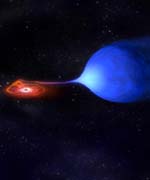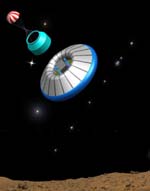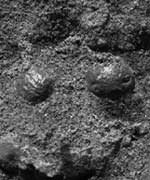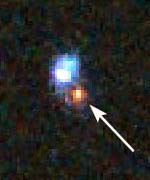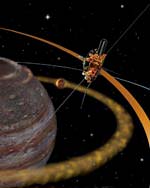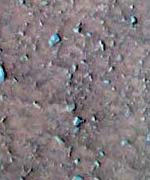
Image credit: NASA/JPL
Opportunity has been getting the lion’s share of the attention in recent weeks, because its twin sister Spirit has been engaged mostly in long-distance driving. But it may be about to steal the spotlight. For several sols, Spirit has been working its way towards nearby Bonneville crater. But even before it gets there, the mobile robot may make a critical discovery. It may find evidence of liquid water on Mars.
Well, not exactly liquid water. Liquid brine, actually. Brine is water that contains dissolved salts. The salts lower the melting temperature of the mixture so that it remains liquid well below the freezing point of pure water. (That’s why road crews “salt” roadways to melt ice in the winter.) Scientists have long speculated that brines, or super brines – a super brine contains high concentrations of dissolved salts – may exist in the martian subsurface.
Spirit’s discovery of patterns in the surface soil at Gusev Crater is what led scientists to believe that there may be subsurface brines there. As of sol 45 (Tuesday, February 17), Spirit had traveled to Laguna Hollow, a small depression located about halfway between Spirit’s landing site and Bonneville crater. In the fine-grained surface material inside the hollow, scientists can see irregular patterns of lines and polygons.
The science team is anxious to learn more about this material, which is unlike anything seen before on Mars. They saw that the topmost layer appeared to be made of different material than what lay just beneath it, and that the surface material stuck to the rover’s wheels.
Dave Des Marais, a science team member from NASA Ames Research Center, explained the possibilities this way: “It could be that it’s a very fine grained dust; fine dust can be coherent when it’s compressed. But it could also have salt in it, or for that matter, a brine or a little bit of water to give it moisture.” On Earth, he said, “you can get that with freeze-thaw type activity, at higher latitudes, such as in tundra. You can also get that in a salt flat, where the salt, by warming, or by wetting and drying, expands and contracts, and forms a very characteristic polygon pattern. You can do it with mud flats, with mud cracks.”
Next on the agenda for Spirit is to dig a deeper trench into the Laguna Hollow material. That, said Des Marais, will enable the MER science team to determine why the material is sticky. “If we’re looking at salt that’s moving up and down, with the assistance of water, we might expect to see a concentration of salt near the surface and as we go deeper perhaps less of a concentration.”
Because the patterns are visible at the surface, Des Marais speculates that they could be due to an active, ongoing process on Mars. Even if the process is currently active, though, that doesn’t necessarily mean there’s a sub-surface body of water present. “I wouldn’t expect to see a pool of water when we dig. You don’t need to have that much [water] to explain these properties that we see. It could be just enough to cause a moistening and a very dense concentrated brine,” he said.
If there is brine beneath the surface at Laguna Hollow, the implications for the possibility of life on Mars could be tremendous. On Earth, some microbes have adapted to thrive in water containing concentrations of salts many times that of sea water. Microbes have also been found eking out a meager existence in tiny brine pockets scattered throughout Arctic sea ice. Scientists know for certain that these microbes can survive at temperatures as low as minus 20 degrees Celsius (minus 4 degrees Fahrenheit). It’s possible that they can live at even lower temperatures.
Meanwhile, Opportunity has completed its first trenching operation into the soil at the floor of the crater where it landed. It will now move on to conduct a more detailed exploration of “El Capitan,” the name that has been given to a portion of the nearby bedrock outcrop. El Capitan offers the most extensive stratigraphic section (the tallest continuous stack of exposed layers, or strata) in the outcrop. The topmost layers appear to be composed of different material than the lower layers. By examining both regions in detail, scientists hope to gain a better understanding of the origin of both the rock matrix (the material the layers are composed of) and the tiny spherules that are embedded within the matrix.
One particularly intriguing discovery at Meridiani is the presence of sulfur on the surface of the bedrock. How the sulfur got there is still unknown. Scientists want to find out whether it is present merely within a surface coating, or deeper within the rock. “If we see it only at the surface and not below the surface,” said Steve Squyres, principle investigator for the MER mission, “then it’s some kind of coating.” That, he said, would “tell us something interesting about recent processes, but it doesn’t tell us about the formation of the outcrop itself.”
If, on the other hand, Opportunity ground into the rock with its RAT and detected sulfur deeper within the rock, it would indicate that the sulfur was around long ago, when the bedrock formed. Scientists would then want to know which sulfate (sulfur-containing) minerals were present within the rock. There are many different types of sulfate minterals. Some form in volcanic environments; many others, such as gypsum, form in the presence of water.
According to Squyres, if the M?ssbauer spectrometer detects “evidence for a sulfate that is the kind that forms only in the presence of liquid water, that would be an extraordinarily exciting finding. That would be probably the most interesting thing that we’d found yet” at Meridiani.
Original Source: Astrobiology Magazine


